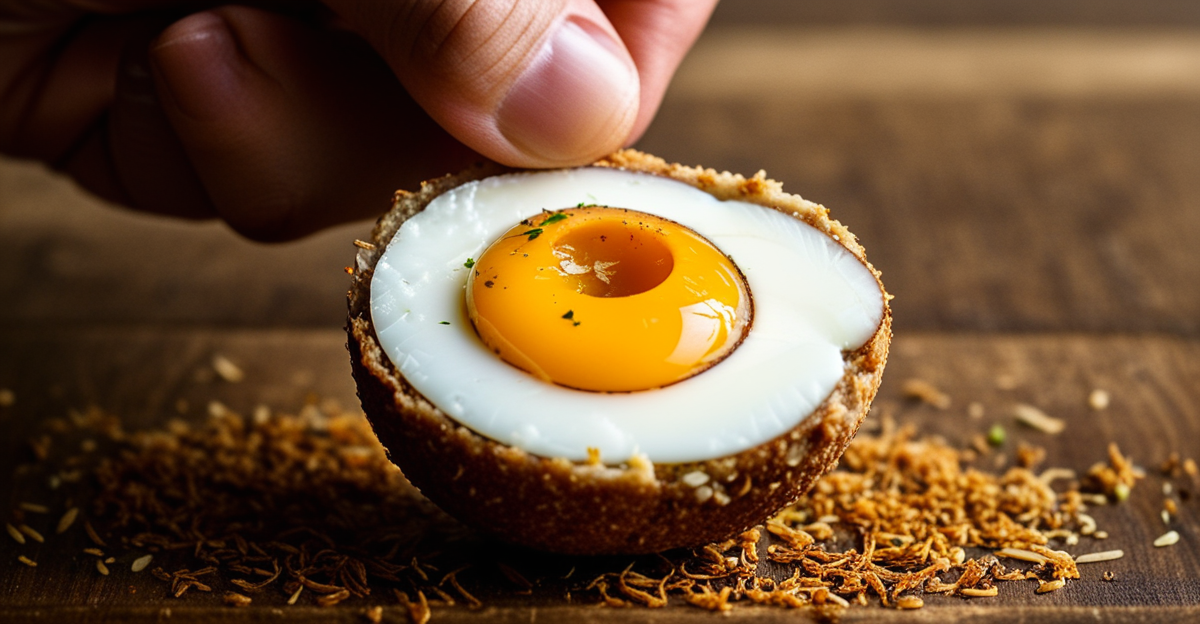Understanding the Traditional Scotch Egg
Traditional Scotch Egg is a classic British delicacy with a rich historical background that dates back to the 18th century. It typically consists of a boiled egg, encased in sausage meat, coated in breadcrumbs, and then deep-fried or baked to perfection. The recipe basics involve selecting high-quality ingredients, such as fresh eggs and seasoned sausage meat.
The art of creating this dish lies in mastering the cooking techniques. Achieving a balanced flavor profile requires a precise blend of herbs and spices, while ensuring the egg remains soft yet firm. The traditional method emphasizes the importance of skilful wrapping to maintain the structural integrity during the cooking process.
Also read : What is the best way to cook a creamy bread and butter pudding?
Delving into the origin of the Scotch egg, it is often attributed to a posh London establishment, Fortnum & Mason, where it was rumored to have been a convenient travel snack. Mastering this classic recipe is essential for anyone looking to explore the essentials of British cuisine and its culinary history. Understanding its preparation techniques can also serve as a foundation for more inventive variations.
Innovative Flavor Variations
In the realm of the Traditional Scotch Egg, creativity reigns supreme as you delve into exciting possibilities with Flavor Variations. While the classic recipe remains cherished, the joy of exploring unique ingredients is irresistibly appealing. Imagine a scotch egg crafted with alternative meats like turkey or lamb, offering a creative cooking experience that respects tradition while branching out into new territories.
Have you seen this : What’s the Secret to Creating a Traditional British Dessert?
Exploiting Culinary Creativity
To truly enhance flavor, consider experimenting with an array of spices and herbs. Adding a dash of smoked paprika or fresh coriander can transform the ordinary into extraordinary. This inventive approach not only elevates the taste but also invites personalization, allowing the dish to mirror individual preferences.
Embracing Local and Seasonal Ingredients
Harnessing the freshness of seasonal ingredients can invigorate your scotch egg delights. Incorporating locally sourced vegetables or fruits can add vibrant color and burst of freshness. Thus, each bite not only speaks to rich tradition but also embodies the essence of place and time. Chefs and home cooks alike, venture into these unique variations and let your imagination lead the way to a delectable surprise.
Step-by-Step Guide to Creating a Savory Scotch Egg with a Twist
Embarking on a culinary adventure with savory variations of the Scotch Egg can be both exciting and rewarding. This guide will walk you through a recipe guide enriched with creative twists, allowing you to reinvent a classic with innovative flair.
Preparing the Ingredients
To start, gather key ingredients that introduce a twist to the traditional recipe. Consider savory variations such as incorporating spicy chorizo for the sausage base or going for a vegetarian option like lentil and mushroom mix. Ensure your eggs are at room temperature to prevent cracking during boiling.
A fundamental aspect includes properly seasoning and marinating your meat mixture. Infusing flavors like garlic, onions, and a pinch of cumin can elevate the taste. For vegetarian alternatives, adding a handful of finely chopped herbs, such as basil or thyme, can provide aromatic delight.
Wrapping and Cooking Techniques
After preparing your creative twist on the ingredients, focus on the wrapping technique. Encase each boiled egg with an even layer of your chosen meat or vegetarian mix, making sure it is sealed and free of air pockets.
For cooking, you have several methods to choose from. Frying offers a classic, rich flavor with a golden crust, whereas baking presents a lighter, healthier alternative. If adventurous, try combining methods: a preliminary bake followed by a quick fry yields an impeccable, crispy exterior.
Flavor Pairings and Serving Suggestions
To truly enhance your unique creation, consider complementary dips or sauces. A citrusy aioli can balance spicy notes, while a tangy homemade ketchup suits more traditional palates. For a well-rounded dish, pair your eggs with light side dishes like a fresh rocket salad or roasted baby potatoes.
Enhance your presentation by serving on a wooden board with sprigs of fresh herbs. Such thoughtful arrangements make dining both a treat for the eyes and the palate.
Nutritional Information and Serving Sizes
In exploring the nutritional information of a traditional Scotch egg, it is essential to break down the calorie content and macronutrients for precise understanding. A standard Scotch egg generally contains around 200-300 calories, depending on the ingredients used. The primary components include protein from the egg and sausage meat, carbohydrates from the breadcrumbs, and fats from the frying process.
When considering healthier substitutions, opt for lean meats like turkey or chicken, or explore vegetarian alternatives such as lentil mixes to reduce calorie intake. Using whole-grain breadcrumbs and baking instead of frying can further decrease fat content, making it a more suitable choice for those mindful of their dietary needs.
As for serving sizes, they can be adapted for different occasions. For a hearty meal, a whole Scotch egg paired with a side salad or veggies serves as a main course. However, for snacks or appetizers, consider slicing the egg into halves or quarters, allowing for manageable portion sizes that are both satisfying and appropriately nutritious.
Visual Enhancements and Additional Resources
Engaging in creative cooking often extends beyond the recipe itself. Visual aids, such as cooking visuals and recipe videos, can significantly enhance a cook’s ability to master a dish like the Scotch Egg. Seeing the cooking techniques in action enables the viewer to appreciate nuanced steps, from wrapping eggs carefully to achieving the perfect golden crust. These visual guides bridge the gap between textual directions and practical application, fostering a better understanding and greater confidence in replicating the dish successfully.
To further enrich the culinary experience, incorporating additional resources such as cookbooks or recommended websites can provide new perspectives on crafting the perfect Scotch Egg. These tools often offer a plethora of recipe variations, detailed nutritional information, and insights into mastering both classic and innovative spins. For those keen on visual learning, accessing recipe videos or cooking demonstrations online can make the process accessible and enjoyable. By exploring these educational aids, one can cultivate both skill and creativity in the kitchen.





